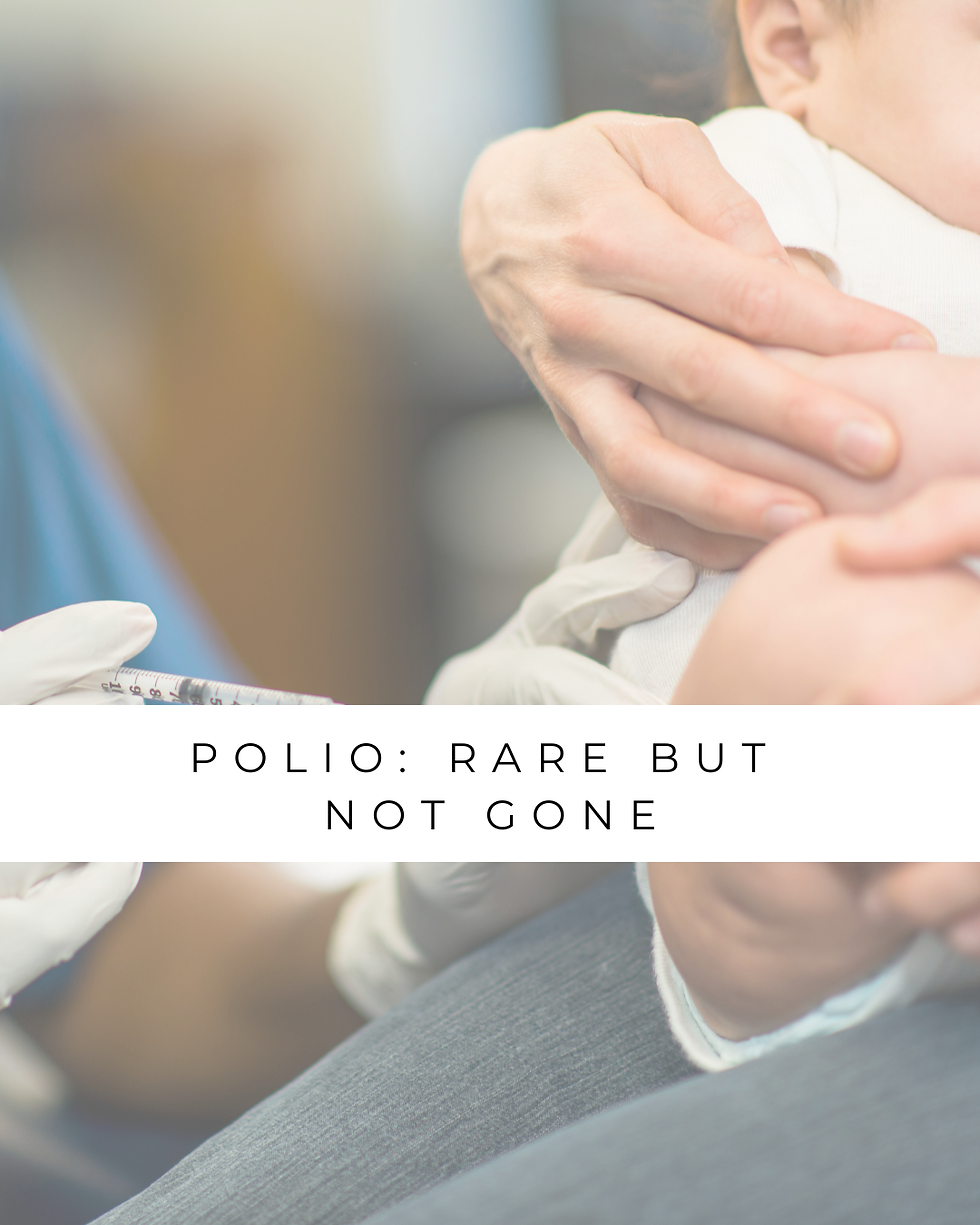Polio: Rare But Not Gone
- Johanna

- Oct 24
- 4 min read
Polio, also known as infantile paralysis, was once one of the most feared diseases. Before the introduction of vaccines, wild polioviruses circulated worldwide.
While many infections caused only mild symptoms, the virus could sometimes lead to severe paralysis or even death. Thanks to effective vaccination, polio is extremely rare today, but continued awareness and immunization remain essential to keep it that way.

What is Polio?
Polio is a viral infection caused by polioviruses types 1, 2, and 3, which belong to the family Enteroviridae. Currently, only type 1 is circulating, while types 2 and 3 have been eradicated. Transmission occurs mainly via the fecal-oral route, through contaminated water or food.
Most infections are mild or asymptomatic. However, severe cases are rare, especially in vaccinated populations. In rare, severe cases, the virus can invade the nervous system and cause permanent paralysis, most commonly of the legs. Some children may develop lifelong muscle weakness or joint deformities.
Years or decades later, after infection, some individuals may experience Post-Polio Syndrome, which can lead to fatigue, pain, and renewed muscle weakness long after recovery from the initial infection.
Vaccination significantly reduces the likelihood of severe outcomes, offering substantial protection against the virus.
Why Polio Still Matters
While Europe is officially polio-free, the disease has not been eradicated globally. Wild-type polioviruses continue to circulate in Afghanistan and Pakistan.
In recent years, vaccine-derived polioviruses (cVDPV) have also been detected in sewage samples across several European countries, including Germany. These are rare mutations from the oral (live) vaccine strains, which are still used in some countries. >>> Read more about it here: https://www.mylittlesprout.de/post/polioviruses<<<
This highlights the importance of maintaining high vaccination coverage to prevent the reintroduction of disease.
Polio Vaccine
Since 1998, Germany has used only the inactivated polio vaccine (IPV). This vaccine contains no live virus and cannot cause the disease.
It provides strong protection against paralysis and severe illness but does not always prevent short-term intestinal infection or viral shedding. Therefore, broad community immunity through high vaccination rates is essential.
The polio vaccine is part of the STIKO (Standing Committee on Vaccination) schedule and is usually administered in combination with other vaccines (e.g., Tetanus, Diphtheria, Pertussis).
Vaccination Schedule in Germany
Primary immunization: During the first year of life (usually as part of the 6-in-1 vaccine)
Booster vaccination: Between 9 and 16 years of age with a Tdap-IPV combination vaccine
Adults: No routine booster is needed if primary immunization and the teenage booster have been completed. A booster is only required in special circumstances, such as incomplete vaccination, occupational exposure, or travel to high-risk regions.
If vaccination status is unclear, a three-dose schedule should be completed.
Possible Vaccine Side Effects
The polio vaccine is safe and well-tolerated.
Typical, mild side effects include:
Redness, swelling, or tenderness at the injection site
Temporary fatigue, low-grade fever, or muscle pain
Serious side effects or allergic reactions are extremely rare.
Read more about the vaccine:
Basic Immunization >>>https://www.mylittlesprout.de/vaccinations/6in1<<<
1. Booster >>>https://www.mylittlesprout.de/vaccinations/polio-(teen)<<<
2. Booster >>>https://www.mylittlesprout.de/vaccinations/2.-booster<<<
Travel and International Requirements
Under the International Health Regulations, travelers to or from countries where polio is still circulating may need to show proof of polio vaccination.
This vaccination must be recorded in the yellow Certificate of Vaccination.
What Parents Should Know
Check your child’s vaccination record: Are all polio doses documented?
If any doses are missed, they can be easily caught up on, even in adolescence or adulthood. To do this, you should contact your pediatrician to discuss your child’s vaccination history. They can develop a tailored catch-up schedule for your child, ensuring all necessary doses are administered appropriately.
Talk to your pediatrician or the Institut for International Health (Tropeninstitut) before traveling to high-risk regions.
Vaccination protects your child and contributes to the global eradication of polio.
Frequently Asked Questions
Can polio be cured?
No. There is no specific antiviral treatment for polio. Care focuses on rehabilitation, physiotherapy, and symptom management. Vaccination remains the only effective protection.
Can the vaccine cause polio?
No. The inactivated vaccine used in Germany today does not contain live virus. Vaccine-associated poliomyelitis occurred only with the old oral live vaccine, which has not been used in Germany since 1998. In recent years, vaccine-derived polioviruses (cVDPV) have also been detected in sewage samples across several European countries, including Germany. >>> Read more about it here: https://www.mylittlesprout.de/post/polioviruses<<<
Why is the teenage booster important?
It strengthens long-term immunity into adulthood. Without this booster, vaccine protection may wane over time.
Conclusion
Polio may sound like a disease from the past, but as long as the virus exists anywhere in the world, there is a risk of reintroduction.
The polio vaccine is well-tested and the most effective way to prevent severe outcomes.
By keeping your child's vaccinations up to date, you not only protect your child but also help in the fight to eliminate polio worldwide. Check vaccination records and consult your doctor if needed.
10/2025
Resources
https://www.rki.de/DE/Themen/Infektionskrankheiten/Infektionskrankheiten-A-Z/P/Polio/polio-node.html





